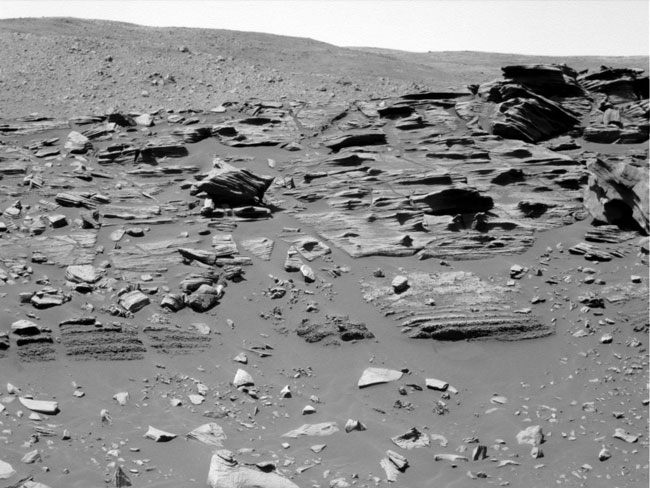Spirit Mars Rover Reaches 'Home Plate': Formation Has Researchers Puzzled

NASA's Spirit Mars rover has arrived at a site dubbed "Home Plate" within Gusev crater. But what the robot found has left scientists puzzled.
As the Mars machinery relays images of the area, the sightseeing has sparked healthy debate within the team running the mission.
"Well, so far it has been great," said Steve Squyres, lead Mars Rover Exploration scientist at Cornell University. "It's the most spectacular layered rock we've ever seen at Gusev," he told SPACE.com.
The images relayed so far by Spirit of Home Plate "really are stunning," Squyres added. "Many of us were pretty much reduced to incoherent babble...like 'WOW!!', 'Holy Toledo!' ... in our emails to one another as the first good pictures were coming down."
But, excitement aside, the real task ahead is attempting to figure out the true nature of Home Plate. "And that's going to take a little while yet," Squyres pointed out.
Picturesque, but a puzzle
"I think it is one of the most picturesque views that we have encountered in either mission thus far," said Jim Rice, a Mars Exploration Rover Project science team member at Arizona State University in Tempe.
Breaking space news, the latest updates on rocket launches, skywatching events and more!
The drive was well worth the effort, Rice told SPACE.com. The outcrop now being studied is layered, but "we're not sure what it is yet."
Tasking Spirit's robot arm to being intensive scrutiny of the area is underway, Rice said. "It is a spectacular scene with Home Plate and all the ridges and buttes."
"Is Home Plate cool or what?", said Larry Crumpler, Research Curator, Volcanology and Space Sciences at the New Mexico Museum of Natural History and Science in Albuquerque, New Mexico.
As a Mars rover science team member, Crumpler said deliberations within the team about what they are viewing "have been the closest thing to passionate debate that I have seen yet."
For his part, Crumpler said that he refuses to accept one spectacular interpretation: "Namely, that it is a volcanic vent structure."
Crumpler said more detailed rover images are needed.
Home Plate has been a target for Spirit since shortly after the robot landed on the red planet in January 2004. The feature stood out in overhead images taken by Mars Global Surveyor's Mars Orbiter Camera. It stood out as a bright, nearly circular spot in the Columbia Hills region, Crumpler explained.
"It has a shape when seen from above that is reminiscent of a playa or evaporite basin...so that has made it a point of possible interest in a mission seeking evidence for past water on Mars," he said.
Diverse hypotheses
As Spirit has wheeled ever closer to Home Plate, and as the rover science team have learned more about what is likely and unlikely in this part of Mars, "I think the hypotheses for Home Plate have gotten more diverse."
Currently these include such possibilities as playa, exhumed crater floor filled with typical Columbia Hills layered deposits, a tuff cone or maar, and a hydrothermal vent area, Crumpler noted. "In fact, it is a healthy debate within the team right now."
But based on previous experience with Mars so far, Crumpler told SPACE.com, it's not wise to place any bets on initial interpretations. The debate is never fully over until Spirit makes use of its science instrument-tipped robot arm, he said.
As for helping pin down what the rover is seeing at Home Plate, there are a bunch of possibilities, Squyres said: Impact deposits, volcanic deposits, maybe wind- or water-lain sediments.
Given Spirit's navigation camera images now in hand, many of the Mars rover science team sense that the rocks are possibly explosive volcanic deposits.
"But that's purely conjecture at this point ... a working hypothesis," Squyres said. "Everything is on the table until we've gotten more data down."

Leonard David is an award-winning space journalist who has been reporting on space activities for more than 50 years. Currently writing as Space.com's Space Insider Columnist among his other projects, Leonard has authored numerous books on space exploration, Mars missions and more, with his latest being "Moon Rush: The New Space Race" published in 2019 by National Geographic. He also wrote "Mars: Our Future on the Red Planet" released in 2016 by National Geographic. Leonard has served as a correspondent for SpaceNews, Scientific American and Aerospace America for the AIAA. He has received many awards, including the first Ordway Award for Sustained Excellence in Spaceflight History in 2015 at the AAS Wernher von Braun Memorial Symposium. You can find out Leonard's latest project at his website and on Twitter.
